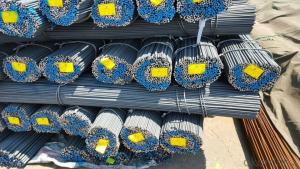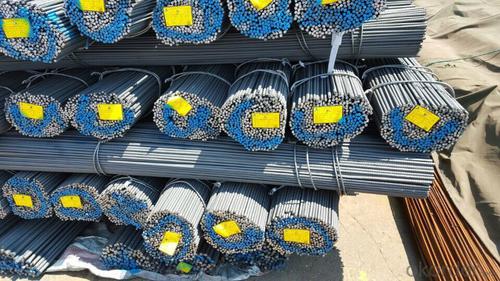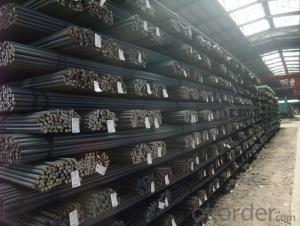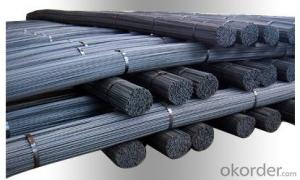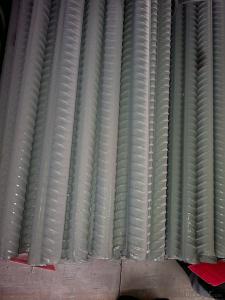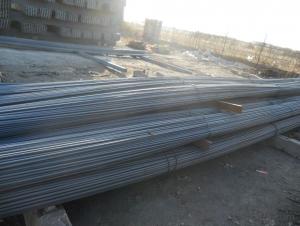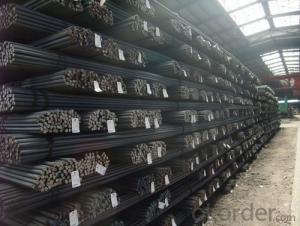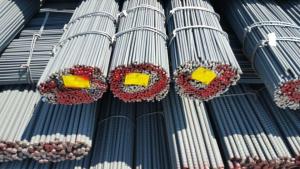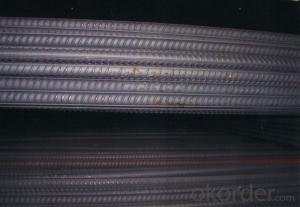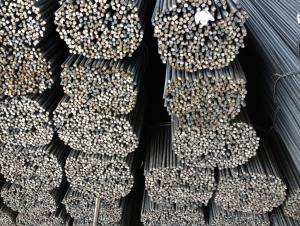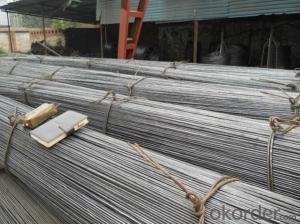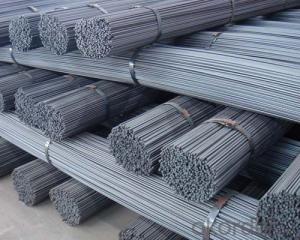Hot Rolled Reinforcing Deformed Steel Bars in Grade HRB400-HRB500
- Loading Port:
- Tianjin
- Payment Terms:
- TT OR LC
- Min Order Qty:
- 25 m.t.
- Supply Capability:
- 20000 m.t./month
OKorder Service Pledge
OKorder Financial Service
You Might Also Like
Specification
OKorder is offering high quality Hot Rolled Rebars at great prices with worldwide shipping. Our supplier is a world-class manufacturer of steel, with our products utilized the world over. OKorder annually supplies products to Africa, North American and Asian markets. We provide quotations within 24 hours of receiving an inquiry and guarantee competitive prices.
Product Applications:
Deformed bar is widely used in buildings, bridges, roads and other engineering construction. Big to highways, railways, bridges, culverts, tunnels, public facilities such as flood control, dam, small to housing construction, beam, column, wall and the foundation of the plate, deformed bar is an integral structure material. With the development of world economy and the vigorous development of infrastructure construction, real estate, the demand for deformed bar will be larger and larger.
Product Advantages:
OKorder's Hot Rolled Rebars are durable, strong, and resist corrosion.
Main Product Features:
· Premium quality
· Prompt delivery & seaworthy packing (30 days after receiving deposit)
· Corrosion resistance
· Can be recycled and reused
· Mill test certification
· Professional Service
· Competitive pricing
Product Specifications:
Manufacture: Hot rolled
Grade: HRB400 – HRB500
Certificates: ISO, SGS, BV, CIQ
Length: 6m – 12m, as per customer request
Packaging: Export packing, nude packing, bundled
Grade | Technical data of the original chemical composition (%) | ||||||
C | Mn | Si | S | P | V | ||
HRB400 | ≤0.25 | ≤1.60 | ≤0.80 | ≤0.045 | ≤0.045 | 0.04-0.12 | |
Physical capability | |||||||
Yield Strength (N/cm²) | Tensile Strength (N/cm²) | Elongation (%) | |||||
≥400 | ≥570 | ≥14 | |||||
Theoretical weight and section area of each diameter as below for your information:
Diameter(mm) | Section area (mm²) | Mass(kg/m) | Weight of 12m bar(kg) |
6 | 28.27 | 0.222 | 2.664 |
8 | 50.27 | 0.395 | 4.74 |
10 | 78.54 | 0.617 | 7.404 |
12 | 113.1 | 0.888 | 10.656 |
14 | 153.9 | 1.21 | 14.52 |
16 | 201.1 | 1.58 | 18.96 |
18 | 254.5 | 2.00 | 24 |
20 | 314.2 | 2.47 | 29.64 |
22 | 380.1 | 2.98 | 35.76 |
25 | 490.9 | 3.85 | 46.2 |
28 | 615.8 | 4.83 | 57.96 |
32 | 804.2 | 6.31 | 75.72 |
36 | 1018 | 7.99 | 98.88 |
40 | 1257 | 9.87 | 118.44 |
50 | 1964 | 15.42 | 185.04 |
FAQ:
Q1: Why buy Materials & Equipment from OKorder.com?
A1: All products offered by OKorder.com are carefully selected from China's most reliable manufacturing enterprises. Through its ISO certifications, OKorder.com adheres to the highest standards and a commitment to supply chain safety and customer satisfaction.
Q2: How do we guarantee the quality of our products?
A2: We have established an advanced quality management system which conducts strict quality tests at every step, from raw materials to the final product. At the same time, we provide extensive follow-up service assurances as required.
Q3: How soon can we receive the product after purchase?
A3: Within three days of placing an order, we will begin production. The specific shipping date is dependent upon international and government factors, but is typically 7 to 10 workdays.
Q4: Can you offer the third part inspection certificates ?
A4: Yes, we can apply third part inspection before shipping, such as SGS, BV, etc .
Images
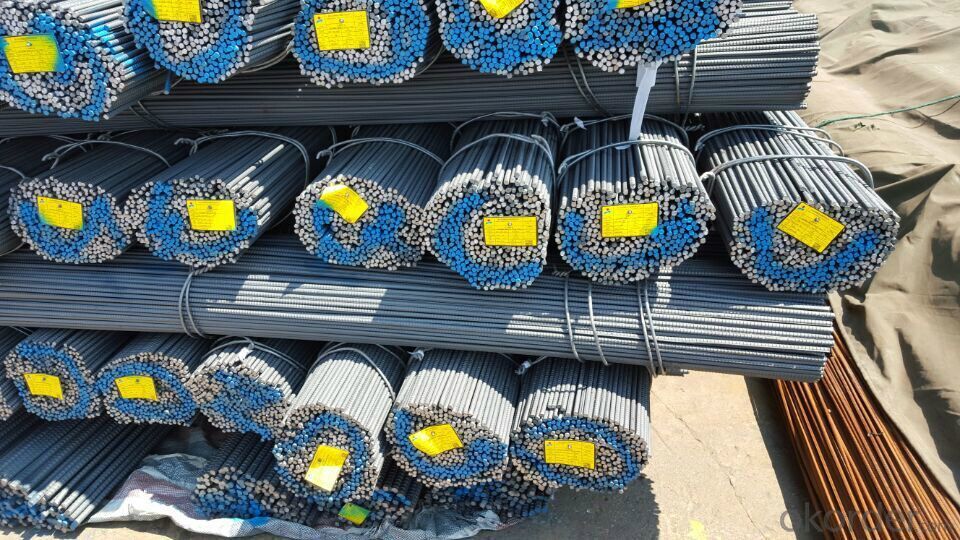
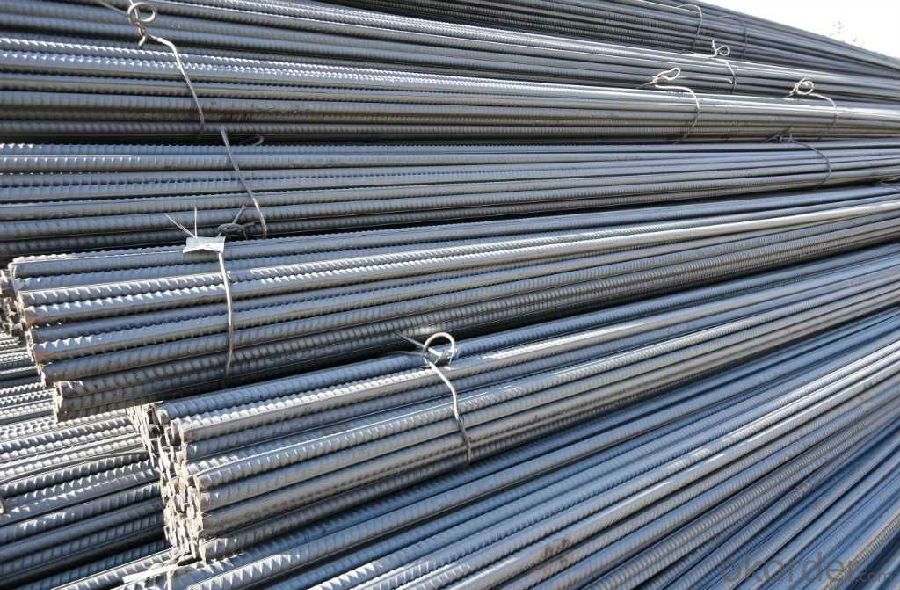
- Q: What is the effect of carbonation on steel rebars?
- The effect of carbonation on steel rebars is primarily detrimental. Carbonation refers to the process in which carbon dioxide from the atmosphere reacts with the alkaline compounds in concrete, lowering its pH level. This reduction in pH causes a gradual decrease in the passivation layer of steel rebars, which is a protective layer that prevents corrosion. When the passivation layer is compromised due to carbonation, the steel rebars become more susceptible to corrosion. Carbon dioxide reacts with moisture in the concrete, producing carbonic acid, which further lowers the pH level and accelerates the corrosion process. As corrosion progresses, the steel rebars can lose their structural integrity, compromising the overall strength and durability of the concrete structure. The expansion of corrosion products can also exert pressure on the surrounding concrete, leading to cracking and spalling. This can expose the steel rebars to more moisture and oxygen, exacerbating the corrosion process. Furthermore, carbonation can also reduce the effectiveness of any protective coatings applied on the rebars, making them even more vulnerable to corrosion. To mitigate the effects of carbonation on steel rebars, several preventive measures can be taken. These include using concrete with a lower permeability to carbon dioxide, ensuring proper concrete cover thickness, and using corrosion-resistant steel with a higher level of chromium and/or other alloying elements. Regular monitoring and maintenance of the concrete structures are also essential to detect and address any signs of corrosion at an early stage. In summary, carbonation can have a detrimental effect on steel rebars by compromising the passivation layer, leading to corrosion and weakening of the structure. Therefore, it is crucial to implement preventive measures and regular maintenance to ensure the long-term durability and safety of steel-reinforced concrete structures.
- Q: How do steel rebars prevent concrete from cracking?
- Steel rebars prevent concrete from cracking by providing reinforcement and increasing its strength. When concrete is poured, it is initially in a liquid state and lacks tensile strength, meaning it is prone to cracking under tension. However, steel rebars are embedded within the concrete structure, forming a strong bond with the concrete as it hardens. The rebars act as a framework within the concrete, distributing the tensile forces evenly throughout the structure. When external forces, such as load or temperature changes, act on the concrete, the rebars resist the tensile stresses that would otherwise cause cracks to form. This is because steel has a much higher tensile strength compared to concrete. Moreover, steel rebars also help to control cracks that may occur due to shrinkage during the curing process of concrete. As the concrete dries and hardens, it undergoes a chemical reaction that causes it to shrink. This shrinkage can lead to cracks, but the presence of rebars restrains the concrete from expanding or contracting excessively, reducing the likelihood of cracking. In addition to preventing cracks, steel rebars also enhance the overall structural integrity of the concrete. They help to distribute the load evenly, making the concrete structure more resistant to bending, shearing, and other forces. This reinforcement ensures that the concrete can withstand the anticipated loads and maintain its stability over time. Overall, steel rebars play a crucial role in preventing concrete from cracking by providing tensile strength and reinforcement. By distributing tensile forces, controlling shrinkage, and enhancing structural integrity, they ensure that the concrete remains strong, durable, and resistant to cracking, thereby prolonging its lifespan and ensuring its stability.
- Q: What is the role of steel rebars in preventing concrete spalling due to fire?
- The prevention of concrete spalling caused by fire heavily relies on steel rebars. Spalling, which occurs when concrete cracks or flakes off under intense heat, such as during a fire, can be mitigated by embedding steel rebars, also known as reinforcement bars, within the concrete structure. In the event of a fire, the temperature can rapidly rise, causing the moisture within the concrete to transform into steam. This steam generates pressure within the concrete, leading to spalling. However, the presence of steel rebars helps address this issue. Steel possesses a higher melting point than concrete and exhibits exceptional thermal conductivity. When exposed to high temperatures, the steel rebars effectively conduct and disperse heat more efficiently compared to the surrounding concrete. This heat transfer assists in minimizing the temperature gradient within the concrete, thereby reducing the risk of spalling. Moreover, steel rebars serve as reinforcement, ensuring the cohesion of the concrete. In instances of spalling, the rebars aid in maintaining the structural integrity of the concrete by preventing complete disintegration. They provide supplementary strength and support, rendering the concrete more resistant to cracking and breaking. In conclusion, steel rebars are integral in preventing concrete spalling caused by fire. They facilitate heat dissipation, diminish temperature gradients, and offer structural support to the concrete. By enhancing the fire resistance of the concrete, steel rebars contribute to the overall safety and durability of the structure.
- Q: What are the different types of surface finishes available for steel rebars?
- Steel rebars come in a variety of surface finishes, each with its own unique characteristics and advantages. Let's take a look at some of the most common types: 1. Black/Uncoated Finish: The simplest surface finish for steel rebars is leaving them in their natural state without any additional coating or treatment. While this finish doesn't provide corrosion protection, it is often used when the rebars will be encased in concrete. 2. Epoxy-Coated Finish: This finish involves applying a layer of epoxy coating to the surface of the rebar. The coating offers excellent corrosion resistance and increases the lifespan of the rebar. Epoxy-coated rebars are commonly used in marine environments or structures exposed to harsh weather. 3. Galvanized Finish: Galvanizing is the process of adding a layer of zinc coating to the rebar's surface. This coating acts as a barrier against corrosion and provides long-lasting protection. Galvanized rebars are frequently used in areas with high moisture content or structures exposed to corrosive chemicals. 4. Stainless Steel Finish: Stainless steel rebars are made from a corrosion-resistant alloy with a high chromium content. This finish is extremely resistant to corrosion, even in challenging environments. It is commonly used in structures that require long-term durability, such as bridges and parking garages. 5. Ribbed Finish: Ribbing refers to the pattern or texture added to the rebar's surface. This finish improves the bond strength between the rebar and the surrounding concrete, enhancing the structural integrity of the construction. Ribbed finishes are often used in reinforced concrete structures. When choosing a surface finish for steel rebars, it's crucial to consider the specific requirements of your project. Factors such as environmental conditions, moisture or chemical exposure, and the desired lifespan of the structure will all influence your choice. Seeking advice from a structural engineer or construction professional can help you determine the most suitable finish for your particular application.
- Q: What is the recommended diameter of steel rebars for foundation reinforcement?
- The recommended diameter of steel rebars for foundation reinforcement typically ranges from 10mm to 25mm, depending on the specific requirements of the project and the structural engineer's design.
- Q: What are the different types of surface finishes available for steel rebars?
- Steel rebars come in a variety of surface finishes, each with its own unique characteristics and advantages. Let's take a look at some of the most common types: 1. Black/Uncoated Finish: The simplest surface finish for steel rebars is leaving them in their natural state without any additional coating or treatment. While this finish doesn't provide corrosion protection, it is often used when the rebars will be encased in concrete. 2. Epoxy-Coated Finish: This finish involves applying a layer of epoxy coating to the surface of the rebar. The coating offers excellent corrosion resistance and increases the lifespan of the rebar. Epoxy-coated rebars are commonly used in marine environments or structures exposed to harsh weather. 3. Galvanized Finish: Galvanizing is the process of adding a layer of zinc coating to the rebar's surface. This coating acts as a barrier against corrosion and provides long-lasting protection. Galvanized rebars are frequently used in areas with high moisture content or structures exposed to corrosive chemicals. 4. Stainless Steel Finish: Stainless steel rebars are made from a corrosion-resistant alloy with a high chromium content. This finish is extremely resistant to corrosion, even in challenging environments. It is commonly used in structures that require long-term durability, such as bridges and parking garages. 5. Ribbed Finish: Ribbing refers to the pattern or texture added to the rebar's surface. This finish improves the bond strength between the rebar and the surrounding concrete, enhancing the structural integrity of the construction. Ribbed finishes are often used in reinforced concrete structures. When choosing a surface finish for steel rebars, it's crucial to consider the specific requirements of your project. Factors such as environmental conditions, moisture or chemical exposure, and the desired lifespan of the structure will all influence your choice. Seeking advice from a structural engineer or construction professional can help you determine the most suitable finish for your particular application.
- Q: How are steel rebars protected against galvanic corrosion?
- Steel rebars are protected against galvanic corrosion through various methods such as applying epoxy coatings, using galvanizing techniques, or utilizing corrosion inhibitors. These protective measures create a barrier between the steel rebars and the corrosive environment, preventing galvanic corrosion from occurring.
- Q: What are the guidelines for protecting steel rebars during concrete pouring?
- Some guidelines for protecting steel rebars during concrete pouring include ensuring proper placement and alignment of rebars, using plastic or epoxy-coated rebars to prevent corrosion, providing adequate concrete cover over the rebars, using protective caps on exposed ends, and avoiding over-vibration of the concrete to prevent rebars from shifting. Additionally, it is important to protect rebars from moisture and contamination during storage and construction, and to follow industry standards and specifications for reinforcement placement and protection.
- Q: Are steel rebars suitable for use in hospital construction?
- Indeed, steel rebars are a suitable option for hospital construction. Referred to as reinforcing bars, steel rebars are commonly utilized in construction projects to impart strength and stability to concrete structures. In the context of hospital construction, where safety and durability are of utmost importance, steel rebars offer numerous benefits. First and foremost, steel rebars possess remarkable tensile strength, enabling them to endure heavy loads and resist deformation. This attribute is critical in hospital construction, where the edifice must support the weight of medical equipment, patients, and other infrastructure. Furthermore, steel rebars bolster the overall structural integrity of the hospital, guaranteeing long-term stability and safety. Moreover, steel rebars exhibit excellent fire resistance properties. Hospitals are classified as high-risk establishments, as they house potentially flammable materials and electrical equipment. Steel rebars can endure high temperatures without compromising their strength, thus enhancing the structure's fire protection. Additionally, steel rebars are resistant to corrosion, shielding the concrete from damage caused by moisture and chemicals. Hospitals often experience elevated humidity levels and exposure to various chemicals employed in medical procedures. Through the utilization of steel rebars, the risk of corrosion and subsequent structural deterioration is minimized, ensuring a prolonged lifespan for the hospital building. Lastly, steel rebars are easily obtainable and cost-effective. Hospital construction projects frequently adhere to strict timelines, and the use of steel rebars enables efficient construction and swift installation. Furthermore, the market's abundance of steel rebars ensures competitive pricing, rendering them a cost-effective choice for hospital construction. In conclusion, steel rebars are unquestionably suitable for employment in hospital construction. Their high tensile strength, fire resistance, corrosion resistance, and cost-effectiveness render them an ideal selection for guaranteeing the safety, durability, and long-term stability of hospital structures.
- Q: How are steel rebars inspected for quality control?
- Steel rebars are inspected for quality control through several methods. Visual inspections are conducted to check for any visible defects such as cracks, surface irregularities, or improper dimensions. Non-destructive testing techniques like ultrasonic testing and magnetic particle inspection are used to detect internal flaws or discontinuities. Rebars are also subjected to destructive testing, including tensile and bend tests, to assess their mechanical properties and ensure they meet the required standards. Additionally, chemical composition analysis is performed to verify the steel's composition and adherence to specifications.
Send your message to us
Hot Rolled Reinforcing Deformed Steel Bars in Grade HRB400-HRB500
- Loading Port:
- Tianjin
- Payment Terms:
- TT OR LC
- Min Order Qty:
- 25 m.t.
- Supply Capability:
- 20000 m.t./month
OKorder Service Pledge
OKorder Financial Service
Similar products
Hot products
Hot Searches
Related keywords
